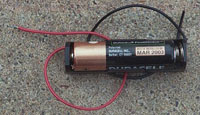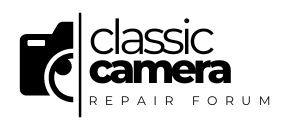
|
These are nothing but wires with insulated alligator clips
soldered to the ends. Radio Shack part number 278-1156 or equivalent should
be adequate. Small gauge wire and short (14") lengths will be the easiest
to use…
The primary usage will be in shorting around wires to test for circuit continuity. |

|
Radio Shack part number 270-401. This is a single AA battery
holder that is very handy to test if galvanometers are working. Just momentarily
touch power to the galvanometer contacts. If the needle jumps, it is good.
Warning: do not leave battery connected to galvanometer. Galvanometers have
very small wires and may not like lots of current passing through them.
You may even wish to put a resistor in series with the battery.
Another handy use is to power a camera when power must be connected then removed several times. Saves the effort of installing/uninstalling the standard camera battery repeatedly. Just clip one wire (on most cameras this will be the holders red wire) to the frame using a test lead then use the other holder wire (black) as a powered probe. I also have a two AA battery holder I use for the same purposes. Radio Shack part number 270-408. |

|
A good digital multimeter is invaluable in circuit testing.
An analog meter is fine but a digital one is easier to read and can also
be used in a cheapie
Shutter Speed Tester
you can make.
One of the best, inexpensive ones you can get is the Elenco M-1000B . It can be purchased online at Micro-tools or C&S Sales. Radio Shack also carries many good meters. Although I have the older Elenco M-1000A, I favor my Metex ME-11 because it can be connected to my laptop and data samples saved without me picking up a pencil. And it can be used as a limited oscilloscope. An expensive meter like this is not necessary for camera repair. I just found it on sale one day so cheap that I couldn’t resist. If you have a multimeter you have probably read the instructions so I won’t go into how to use one testing a camera.
|
Posted inGeneral Repair
